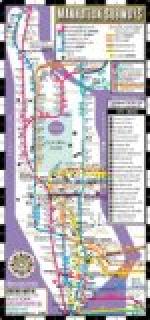The return rails are cross-sectioned at frequent intervals for the purpose of equalizing currents which traverse them.
[Sidenote: Contact Rail Guard and Collector Shoe]
The Interborough Company has provided a guard in the form of a plank 8-1/2 inches wide and 1-1/2 inches thick, which is supported in a horizontal position directly above the rail, as shown in the illustration on page 113. This guard is carried by the contact rail to which it is secured by supports, the construction of which is sufficiently shown in the illustration. This type of guard has been in successful use upon the Wilkesbarre and Hazleton Railway for nearly two years. It practically eliminates the danger from the third rail, even should passengers leave the trains and walk through a section of the tunnel while the rails are charged.
Its adoption necessitates the use of a collecting shoe differing radically from that used upon the Manhattan division and upon the elevated railways employing the third rail system in Chicago, Boston, Brooklyn, and elsewhere. The shoe is shown in the photograph on page 114. The shoe is held in contact with the third rail by gravity reinforced by pressure from two spiral springs. The support for the shoe includes provision for vertical adjustment to compensate for wear of car wheels, etc.
CHAPTER VI
ELECTRICAL EQUIPMENT OF CARS
In determining the electrical equipment of the trains, the company has aimed to secure an organization of motors and control apparatus easily adequate to operate trains in both local and express service at the highest speeds compatible with safety to the traveling public. For each of the two classes of service the limiting safe speed is fixed by the distance between stations at which the trains stop, by curves, and by grades. Except in a few places, for example where the East Side branch passes under the Harlem River, the tracks are so nearly level that the consideration of grade does not materially affect determination of the limiting speed. While the majority of the curves are of large radius, the safe limiting speed, particularly for the express service, is necessarily considerably less than it would be on straight tracks.
The average speed of express trains between City Hall and 145th Street on the West Side will approximate 25 miles an hour, including stops. The maximum speed of trains will be 45 miles per hour. The average speed of local and express trains will exceed the speed made by the trains on any elevated railroad.




